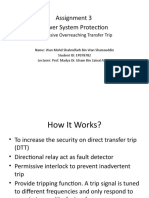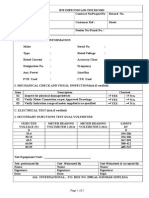0.1 CT Sizing - Tech
Uploaded by
srinivasaphanikiran0.1 CT Sizing - Tech
Uploaded by
srinivasaphanikiranINTRODUCTION
FUNDAMENTALS OF CT
Current transformer isolates the measurement and protection circuit from the primary high voltage level and
transforms the power system current to a smaller secondary current which can be easily accessed by protection and
measurement circuit.
Based on the application CTs are classified as
1. Protection CT
2. Metering CT
In protection application one is concerned about the performance and error of the C.T. during fault and normal
condition, On the other hand metering application errors are of concern under normal condition and not of concern
when faulted or abnormal condition occur.
The performance of current transformer is very vital to correct operation of a protection system. If current transformer
is not properly selected, saturation of CT core will occur and leads to relay malfunctioning.
Designing the CT for a protection application has always been a challenge, over dimension results in costly and over-
sized CT, while under dimensioned CT results in incorrect measurement of the power system current and makes the
protection system unreliable.
Current transformer is an instrument transformer used to lower down the value of current; it basically has single turn
primary and multi turn secondary.
Like voltage transformer it works on the principle of electromagnetic induction, primary produces the changing flux
which links with the secondary winding to induce a voltage in secondary, but the difference is that in voltage
transformer secondary current is varying and based on that the primary current flows that is primary current is a
function of secondary current, but in current transformer the secondary current is a function of primary current, primary
current is a load current that line is carrying, this current is stepped down and connected to the burden, here burden
can be measuring instrument (like ammeter) or it can be a protective relay,
CT basically consist of there parts
1. Primary winding
2. Secondary winding
3. Core
1. Primary winding : primary winding is basically a line that carries the load current that is to be stepped down,
so the core of a transformer is ring shaped which is placed over the line or bulbar so that the line or bulbar
acts as single turn primary, this line current produces the flux that is carried to the secondary winding by core,
there is no of advantages of using a single turn primary as compared to multi turn primary, in case of short
circuits the high value of current produces the forces on the conductor, single turn has low effect of these
forces as compare to multiturns.
2. Secondary winding: secondary winding is multi turn wound on a core, this winding is connected to the burden
3. Core:core is a magnetic circuits used to carry flux, here core is in the ring shape, primary conductor passes from
the center of the ring, core plays very important role in the accuracy of the CT, both ratio error and phase error
depends upon the material of the core
Based on the burden and there requirements, CTs are classified as
1. Metering CTs
2. protection CTs
3. special protection CTs
1. Metering CTs: Measuring CTs are used to measure current under normal condition, for metering CTs we
defined both phase error and ratio error by class of accuracy, these CTs are used to measure current at
normal conditions so there accuracy is defined from 100% to 120%, for metering CT accuracy is given as
class 1, class 2 etc
e.g. for class1 (IS:2075)
2. Potection CTs : these CTs are used to measure current at abnormal condition (faults) and connected to relays to
operate the CBs, fault current is very high in magnitude so there accuracy is defined at higher values of current, for
metering CTs we defined both phase error and ratio error by class of accuracy, for Protection CTs the accuracy is
given at 100% and ALF times normal primary current, for Protection CT accuracy is given as class 5P, class 10P etc,
P stands for protection CT and 5 and 10 for accuracy at Ip*ALF
for e.g. class 5P(IS:2705)
here accuracy at 100% is 1% and at Ip*ALF is 5%
3. Special protection CT are used for special protection systems like difference protection, here defined the turns ratio
error and I
exc
at Vk, Vk/2, Vk/3
PROCEDURE
(i) study of various protection system
(ii) study of various parameters of CT
(iii) collection of data base of various relay requirements of different manufacturers
(iv) CT sizing calculation for each relay
(v) Verification of calculation by using simulation model
(vi) Development of Automated sizing calculation
Study of various protection system, different types of faults, abnormal conditions during faults, ways to measure these
abnormal conditions, role of CTs in measuring these fault conditions.
Study of various parameters of CT.
Formation of data base of various relay requirements of different manufacturers, study the market to find out relays
available for various protection system, collecting these relays details and forming a database of relays.
CT sizing calculation as per relay manufacture and verification of this calculation by forming a simulation model.
STEPS FOR DOING CT SIZING CALCULATION FOR TRANSFORMER FEEDER OVER CURRENT PROTECTION
1.Select CT ratio based on max feeder current
2. calculate fault MVA of transformer fault MVA
3. calculate through fault current I
F(T)
4. calculate lead resistance R
lead
5. calculate total secondary side resistance R
CT
+R
lead
+R
B
6. calculate knee point voltage as V
k
( I
F(T)
/N)(R
CT
+R
lead
+R
B
)
EXAMPLE
Transformer details
Transformer rating=100 MVA
Primary voltage =220 kV
Secondary voltage=33 kV
Max feeder current on primary side= ( 1.1xMVA rating x1000) / ( 1.73x V
p
x min Tap)
= (1.1 x120x1000)/ ( 1.732x220x0.9)
=385 A
Max feeder current on secondary side= ( 1.1xMVA rating x1000) / ( 1.73x V
s
)
= (1.1 x120x1000) / (1.732x33)
=2309 A
CT Ratios Selected
I
P(HV)
500 A Selected tap of main CT at HV side
I
P(LV
) 2500 A Selected tap of main CT at LV side
I
S
1 A Nominal secondary current
Primary side CT
Through fault MVA of transformer =MVA rating/% impedance at ve tap
=120/.1130=1062.417 MVA
Through fault current on primary side IPF(T)=fault MVA/ 1.732xVP
=1062.41/ 1.732 x 220=2.79 kA
Calculate total secondary resistance= RCT+Rlead+RB
=2.5+ 1.916+0.2 ohms
Calculate knee point voltage Vk( IPF(T)/N)(RCT+Rlead+RB)
Vk (2790/500) (2.5+ 1.916+0.2) V
Vk 25.75 V
Secondary side CT
Through fault MVA of transformer =MVA rating/% impedance at ve tap
=120/.1130=1062.417 MVA
Through fault current on primary side IPF(T)=fault MVA/ 1.732xVP
=1062.41/ 1.732 x 33=18.71 kA
Calculate total secondary resistance= RCT+Rlead+RB
=2.5+ 1.916+0.2 ohms
Calculate knee point voltage Vk ( IPF(T) /N)(RCT+Rlead+RB)
Vk (1871/500) (2.5+ 1.916+0.2) V
Vk 17.27 V
CT UNDER SYMMETRICAL FAULT CURRENT
INTRODUCTION
Most of the faults on the power system lead to short-circuit condition. When such a condition occur, a heavy current
(called short circuit current) flows through the equipment, causing considerable damage to the equipment and
interruption of service to the consumers.
That fault on the power system which gives rise to symmetrical currents (i.e. equal fault currents in the line with 120
degree displacement) is called symmetrical fault.
This chapter will show how CT will behave when symmetrical fault occurs and what should be the requirements of the
CT for correctly measuring the symmetrical fault currents.
KNEE-POINT VOLTAGE EQUATION
Figure 1 shows equivalent circuit of CT
WHEN CT SECONDARY VOLTAGE IS LESS THAN CT KNEE POINT VOLTAGE
Details of the CT used for simulation
CT ratio-200/1
CT knee point voltage -34 volts
R
CT
+R
lead
+R
B
=1
CT primary current, I
p
=200A
There fore CT secondary current, I
s
=1A
Now, CT secondary voltage V
s
=I
s
(R
CT
+R
lead
+R
B
) =1(1) =1V
Figure 2 shows the CT secondary current (Is) and CT primary current referred to secondary side (I
p
).
Figure 2 shows that, when secondary voltage of CT is less than Knee point voltage both CT secondary current(I
s
) and
CT primary current referred to secondary side (I
p
) over lapping each other, there is no saturation CT, secondary
current is exact replica of primary current.
WHEN CT SECONDARY VOLTAGE IS MORE THAN CT KNEE POINT VOLTAGE
Details of the CT used for simulation
CT ratio-200/1
CT knee point voltage -34 volts
R
CT
+R
lead
+R
B
=40
CT primary current, I
p
=200A
There fore CT secondary current, I
s
=1A
CT secondary voltage V
s
=I
s
(R
CT
+R
lead
+R
B
) =1(40) = 40V
Now CT knee point voltage (V
k
) is less than CT secondary voltage (V
s
)
Figure 3 shows the CT secondary current (Is) and CT primary current referred to secondary side (I
p
)
Figure 3 shows that when secondary voltage of CT is more than CT knee point voltage, there is saturation in the CT
core and CT secondary current is not exact replica of primary current.
WHEN CT SECONDARY VOLTAGE IS EQUAL TO CT KNEE POINT VOLTAGE
Details of the CT used for simulation
CT ratio-200/1
CT knee point voltage -34 V
R
CT
+R
B
+R
lead
=34
CT primary current, I
p
=200A
There fore CT secondary current, I
s
=1A
CT secondary voltage V
s
=I
s
(R
CT
+R
lead
+R
B
) = 1(34) =34V
Now Ct knee point voltage (V
k
) is equal to the CT secondary voltage (V
s
)
Figure 34 shows the CT secondary current (I
s
) and CT primary current referred to secondary side (I
p
)
Figure 4 shows that the CT saturates after a quarter of a cycle but will remain unsaturated after this. The reason for
this is that the flux in the CT is assumed to be zero when the fault starts. For the first half cycle wave only half of the
flux (+saturation flux-0=saturation flux) is available compared to all the following half wave forms
(+saturation flux-(-saturation flux=2*saturation flux).
That means to avoid this condition we have to select the knee-point voltage at least two times higher as the
secondary voltage generated
Figure 5 shows that when knee point voltage of CT is equal to twice CT secondary voltage both CT secondary
current(I
s
) and CT primary current referred to secondary side over lapping each other, there is no saturation CT
secondary current is exact replica of primary current.
RESULTS
From the above simulation following results are obtained.
Table 1 Results for Symmetrical Fault Current
Relay saturation free time Knee point voltage
Less than quarter cycle (I
sc
/N)(R
CT
+R
lead
+R
B
)
In between quarter and half cycle 2*(I
sc
/N) (R
CT
+R
lead
+R
B
)
More than half cycle (I
sc
/N) (R
CT
+R
lead
+R
B
)
CT UNDER TRANSIENT FAULT CURRENT
Initially current transformer (CT) sizing criteria were based on traditional symmetrical calculations, assuming
that fault current is sinusoidal but in actual fault current is transient in nature.
Transient fault current during first few cycles contains both ac and dc components, dc component decays over
the time. Time constant for this transient is proportional to X/R ratio of that primary system at the fault location.
DC component in the transient fault current will cause the flux in the CT core to rise faster than it would have
with sinusoidal current. Thus it is necessary to over dimension the CT.
Now days fast numerical relays are used for protection systems capable of detecting fault ranging from quarter
cycle to cycle time. If traditional symmetrical calculation approach for CT sizing is used it will not provide correct
value of power system current to the relays making the protection system unreliable.
KNEE POINT VOLTAGE EQUATION
Consider primary fault current as
Putting this value of B (t
sat
) in equation above we get
TRANSFORMER FEEDER OVER CURRENT PROTECTION
OVERCURRENT PROTECTION:
Figure shows block diagram of over current relay.
1.Primary CT: The purpose of the primary CT is to reproduce the primary current waveform to the relay aux CT.
2. Low pass filter: low pass filter to remove any high frequency content.
3. Sample and Hold amplifier: Samples and hold analog signals at time interval determine by the sampling clock to
preserve the phase information
4. Multiplexer: Select one sample and hold sample at a time for subsequent scaling and conversion for digital
conversion
5. Programmable gain amplifier- used for amplification of signal
6. Analog to digital (A/D) conversion: An A/D converter converts analog signal to a digital signal.
7. Microprocessor-Microprocessor with appropriate software that provides the required protection characteristic that
are amplified to operate auxiliary units for tripping, closing, alarms and so on.
Signal from CT is first brought into Low pass filter that remove frequency content about 1/2 or 1/3 of the sampling
frequency (According to Nyquist criterion, A relay A/D converter needs to sample faster than 2x per cycle to the
highest frequency that is it to monitor), for e.g. for 50 Hz system, A/D converter sampling rate is 2 sample per cycle
and cut of frequency of 50Hz.
Modern Numeric relay samples ranging from 16 to 24 samples per power system cycle. In some relays, the entire
sampled data is kept for oscillographic records, but in the relay, only the fundamental component is needed for most
protection algorithms, unless a high speed algorithm is used that uses sub cycle data to monitor for fast changing
issues. The sampled data is then passed through a low pass filter that numerically removes the frequency content that
is above the fundamental frequency of interest (i.e., nominal system frequency), and uses Fourier transform
algorithms to extract the fundamental frequency magnitude and angle. Next the microprocessor passes the data into a
set of protection algorithms, which are a set of logic equations in part designed by the protection engineer, and in part
designed by the relay manufacturer, that monitor for abnormal conditions that indicate a fault. If a fault condition is
detected, output contacts operate to trip the associated circuit breaker(s).
Over current relay are designed to operate under saturation conditions, there is no need of considering the transient
dimensioning factor for calculating the knee-point voltage.
Over current relay take decision based on primary frequency component only, it neglects the dc component, so there
is no need of considering transient over-dimensioning factor
Over current relay are designed to operate under saturation conditions, there is no need of considering the transient
dimensioning factor for calculating the knee-point voltage.
Over current relay take decision based on primary frequency component only, it neglects the dc component, so there
is no need of considering transient over-dimensioning factor.
OVER CURRENT PROTECTION OF TRANSFORMER FEEDER:
Over current relay cannot be used for primary protection without the risk of internal faults causing extensive damage
to the transformer. Differential protection of transformer protects transformer from internal faults but incase of external
through fault current it does not protect the transformer.
A through fault external to transformer results in an overload that can cause transformer failure if the fault is not
cleared promptly. It is widely reorganized that damage to transformer.
Over current protection for transformer feeder is used to protect the transformer from external through faults and over
loads. It is basically a back up protection, which operates when the unit protection of transformer and load side
protection system does not operate.
Consider the fig given below.
Now if the overload protection system on load side and unit protection system fails the transformer feeder over current
protection acts as back up protection.
Protection relay used for back up protection is either definite time or inverse time relay and have there operating time
much after the main protection operating time, which can be calculated as
Breker operating time=0. 1s
Relay overshoot=.05s
Allow.For error=.15s
Safety margin=0.1s
Total=0.4s
So operating time of backup relay starts much after the main protection system and the dc transient components
delays to zero up to that point and also Over current relay eliminates the dc component from the current, so there is
no need of considering the transient dimensioning factor, so the knee point voltage of CT used for back up protection
of transformer is given as
Setting current of backup relay should be such that it protects the transformer from damage without the protection
device operates.
For transformer feeder over current protection
Consider a simulation result
CT ratio 200/1
Nominal CT primary current Ipn-200A
Nominal CT secondary current-1A
Maximum fault primary current =20*Ipn=4000A
Knee-point voltage is taken as
Rct+Rlead+Rrelay= 1.7
There fore Vk=34
Now taking Ip=Ipn, CT secondary current is given as
Taking Ip=20Ipn
Taking Ip=25Ipn
Taking Ip=30Ipn
Plotting curve between primary current /nominal primary current and secondary current/nominal secondary current
This is clear from above waveforms and graphs that after reaching the CT into saturation the rms value of CT
secondary current is still more than setting current and there is no need of considering the transient over dimension
factor.
STEPS FOR DOING CT SIZING CALCULATION FOR TRANSFORMER FEEDER OVER CURRENT PROTECTION
1. Select CT ratio based on max feeder current
2. calculate fault MVA of transformer fault MVA
3. calculate through fault current I
F(T)
4. calculate lead resistance R
lead
5. calculate total secondary side resistance R
CT
+R
lead
+R
B
6. calculate knee point voltage as V
k
( I
F(T)
/N)(R
CT
+R
lead
+R
B
)
EXAMPLE
Transformer details
Transformer rating=100 MVA
Primary voltage =220 kV
Secondary voltage=33 kV
Max feeder current on primary side= ( 1.1xMVA rating x1000) / ( 1.73x V
p
x min Tap)
= ( 1.1 x120x1000)/ ( 1.732x220x0.9)
=385 A
Max feeder current on secondary side= ( 1.1xMVA rating x1000) / ( 1.73x V
s
)
= ( 1.1 x120x1000) / ( 1.732x33)
=2309 A
CT ratio selected
I
P(HV)
500 A Selected tap of main CT at HV side
I
P(LV
) 2500 A Selected tap of main CT at LV side
I
S
1 A Nominal secondary current
Primary side CT
Through fault MVA of transformer =MVA rating/% impedance at ve tap
=120/.1130=1062.417 MVA
Through fault current on primary side I
PF(T)
=fault MVA/ 1.732xV
P
=1062.41/ 1.732 x 220=2.79 kA
Calculate total secondary resistance= R
CT
+R
lead
+R
B
=2.5+ 1.916+0.2 ohms
Calculate knee point voltage V
k
( I
PF(T)
/N)(R
CT
+R
lead
+R
B
)
V
k
(2790/500) (2.5+ 1.916+0.2) V
V
k
25.75 V
Secondary side CT
Through fault MVA of transformer =MVA rating/% impedance at ve tap
=120/.1130=1062.417 MVA
Through fault current on primary side I
PF(T)
=fault MVA/ 1.732xV
P
=1062.41/ 1.732 x 33=18.71 kA
Calculate total secondary resistance= R
CT
+R
lead
+R
B
=2.5+ 1.916+0.2 ohms
Calculate knee point voltage V
k
( I
PF(T)
/N)(R
CT
+R
lead
+R
B
)
V
k
(1871/500) (2.5+ 1.916+0.2) V
V
k
17.27 V
PRACTICAL RESULTS
For verifying the above results and CT model, practical experiments were performed on the CT.
Specifications of CT used are as follows
CT ratio-200:1
Knee point voltage of CT-34 V
When CT Secondary Voltage is less than CT Knee Point Voltage
R
CT
+R
lead
= 1.1
R
B
=10.1
CT primary current=50A
Standard CT measured current=5A (50/5 ratio used)
CT under test measured current=.24 A (200/1 ratio)
CT secondary Voltage measured with CRO=2.432 V (RMS)
When CT Secondary Voltage is more than CT Knee Point Voltage
R
CT
+R
lead
= 1.1
R
B
=490
CT primary current=50A
Standard CT measured current=5A (50/5 ratio used)
CT under test measured current=.1 A (200/1 ratio)
CT secondary Voltage measured with CRO =52 V
Figure given below show practical and simulation result of CT secondary current
WHEN CT SECONDARY VOLTAGE IS EQUAL TO CT KNEE POINT VOLTAGE
R
CT
+R
lead
= 1.1
R
B
=135
CT primary current=50A
Standard CT measured current=5A (50/5 ratio used)
CT under test measured current=.189 A (200/1 ratio)
CT secondary Voltage measured with CRO =25.56 V
Figure given below show practical and simulation result of CT secondary current
To avoid this first quarter cycle saturation, taking
R
CT
+R
lead
= 1.1
R
B
=66
CT primary current=50A
Standard CT measured current=5A (50/5 ratio used)
CT under test measured current=.22 A (200/1 ratio)
CT secondary Voltage measured =14.66 V
You might also like
- The Subtle Art of Not Giving a F*ck: A Counterintuitive Approach to Living a Good LifeFrom EverandThe Subtle Art of Not Giving a F*ck: A Counterintuitive Approach to Living a Good Life4/5 (6098)
- The Gifts of Imperfection: Let Go of Who You Think You're Supposed to Be and Embrace Who You AreFrom EverandThe Gifts of Imperfection: Let Go of Who You Think You're Supposed to Be and Embrace Who You Are4/5 (1148)
- Never Split the Difference: Negotiating As If Your Life Depended On ItFrom EverandNever Split the Difference: Negotiating As If Your Life Depended On It4.5/5 (923)
- Hidden Figures: The American Dream and the Untold Story of the Black Women Mathematicians Who Helped Win the Space RaceFrom EverandHidden Figures: The American Dream and the Untold Story of the Black Women Mathematicians Who Helped Win the Space Race4/5 (947)
- The Hard Thing About Hard Things: Building a Business When There Are No Easy AnswersFrom EverandThe Hard Thing About Hard Things: Building a Business When There Are No Easy Answers4.5/5 (361)
- The World Is Flat 3.0: A Brief History of the Twenty-first CenturyFrom EverandThe World Is Flat 3.0: A Brief History of the Twenty-first Century3.5/5 (2283)
- Devil in the Grove: Thurgood Marshall, the Groveland Boys, and the Dawn of a New AmericaFrom EverandDevil in the Grove: Thurgood Marshall, the Groveland Boys, and the Dawn of a New America4.5/5 (278)
- A Heartbreaking Work Of Staggering Genius: A Memoir Based on a True StoryFrom EverandA Heartbreaking Work Of Staggering Genius: A Memoir Based on a True Story3.5/5 (692)
- Complexity in Protecting Three Terminal LineNo ratings yetComplexity in Protecting Three Terminal Line35 pages
- Electrical Systems - Substation Bus SchemesNo ratings yetElectrical Systems - Substation Bus Schemes7 pages
- Difference BN MCB, MCCB, Elcb, RCCB, Acb & VCBNo ratings yetDifference BN MCB, MCCB, Elcb, RCCB, Acb & VCB5 pages
- P59 - Protection & Control / Line Differential Protection RelayNo ratings yetP59 - Protection & Control / Line Differential Protection Relay1 page
- AL International Site Inspection AND Test Record: Page 1 of 2No ratings yetAL International Site Inspection AND Test Record: Page 1 of 22 pages
- The Subtle Art of Not Giving a F*ck: A Counterintuitive Approach to Living a Good LifeFrom EverandThe Subtle Art of Not Giving a F*ck: A Counterintuitive Approach to Living a Good Life
- The Gifts of Imperfection: Let Go of Who You Think You're Supposed to Be and Embrace Who You AreFrom EverandThe Gifts of Imperfection: Let Go of Who You Think You're Supposed to Be and Embrace Who You Are
- Never Split the Difference: Negotiating As If Your Life Depended On ItFrom EverandNever Split the Difference: Negotiating As If Your Life Depended On It
- Hidden Figures: The American Dream and the Untold Story of the Black Women Mathematicians Who Helped Win the Space RaceFrom EverandHidden Figures: The American Dream and the Untold Story of the Black Women Mathematicians Who Helped Win the Space Race
- The Hard Thing About Hard Things: Building a Business When There Are No Easy AnswersFrom EverandThe Hard Thing About Hard Things: Building a Business When There Are No Easy Answers
- Elon Musk: Tesla, SpaceX, and the Quest for a Fantastic FutureFrom EverandElon Musk: Tesla, SpaceX, and the Quest for a Fantastic Future
- The Emperor of All Maladies: A Biography of CancerFrom EverandThe Emperor of All Maladies: A Biography of Cancer
- The Little Book of Hygge: Danish Secrets to Happy LivingFrom EverandThe Little Book of Hygge: Danish Secrets to Happy Living
- The Yellow House: A Memoir (2019 National Book Award Winner)From EverandThe Yellow House: A Memoir (2019 National Book Award Winner)
- The World Is Flat 3.0: A Brief History of the Twenty-first CenturyFrom EverandThe World Is Flat 3.0: A Brief History of the Twenty-first Century
- Devil in the Grove: Thurgood Marshall, the Groveland Boys, and the Dawn of a New AmericaFrom EverandDevil in the Grove: Thurgood Marshall, the Groveland Boys, and the Dawn of a New America
- The Sympathizer: A Novel (Pulitzer Prize for Fiction)From EverandThe Sympathizer: A Novel (Pulitzer Prize for Fiction)
- A Heartbreaking Work Of Staggering Genius: A Memoir Based on a True StoryFrom EverandA Heartbreaking Work Of Staggering Genius: A Memoir Based on a True Story
- Team of Rivals: The Political Genius of Abraham LincolnFrom EverandTeam of Rivals: The Political Genius of Abraham Lincoln
- On Fire: The (Burning) Case for a Green New DealFrom EverandOn Fire: The (Burning) Case for a Green New Deal
- P59 - Protection & Control / Line Differential Protection RelayP59 - Protection & Control / Line Differential Protection Relay
- AL International Site Inspection AND Test Record: Page 1 of 2AL International Site Inspection AND Test Record: Page 1 of 2
- The Unwinding: An Inner History of the New AmericaFrom EverandThe Unwinding: An Inner History of the New America





























































